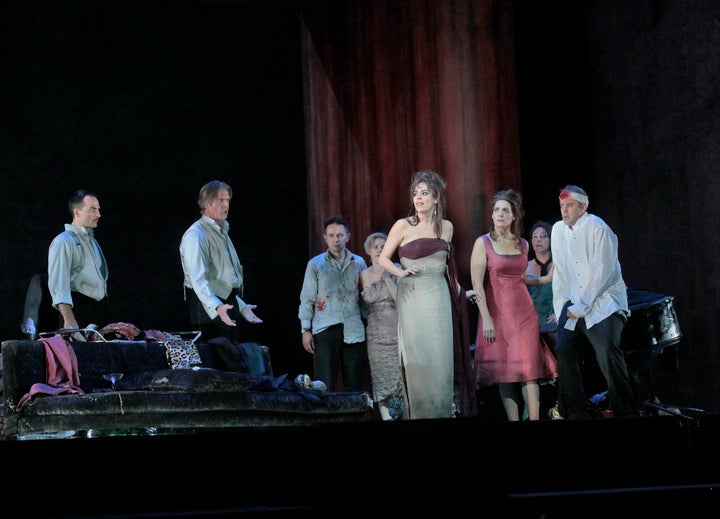
From left, David Adam Moore, Rod Gilfry, Iestyn Davies, Sally Matthews, Audrey Luna, Amanda Echalaz, Christine Rice, and Joseph Kaiser in a scene from “The Exterminating Angel.”
The Metropolitan Opera brought Thomas Ades’ The Exterminating Angel to the stage last night in a spectacular American premiere of one of the most anticipated openings of a new opera in years, and drew a standing ovation from the composer’s devoted fans.
With a cast of dozens and a sweeping modernistic score conducted by the composer, The Exterminating Angel has been awaited with such high expectations that its arrival has gained the status of a major cultural event in New York’s music world.
It is an event the Met Opera will share with audiences around the world when it simulcasts its matinee performance on Nov. 18 to more than 2,000 theaters in 73 countries as part of its Live in HD series.
Ades, a British composer also known for his concertos and symphonic music, turns out an opera about once a decade. His first, Powder Her Face, appeared in 1995. His 2004 work based on Shakespeare’s The Tempest was a big hit when it was staged at the Met in 2012, and Peter Gelb, the Met general manager, quickly signed up to co-produce The Exterminating Angel, which had its debut in Salzburg last year.
The Exterminating Angel is based on a 1962 movie of the same name by Luis Bunuel, a noirish comedy set in Spain about a posh dinner party from which the guests find themselves strangely unable to leave.
Ades and his director John Cairns co-wrote the libretto and pretty much followed the plot of the film, though the number of dinner guests was reduced from 17 in the movie to 12 for the opera, still a large number of principal singers to be onstage at the same time. And Bunuel’s signature underplaying of emotions in his films is reversed on the operatic stage.
Ominous signs of what’s to come begin early. As the orchestra tunes up while the audience is taking their seats, a trio of handsome and woolly sheep appear onstage, followed shortly by a bear. The animals, intended to be entertainment for the party, are soon banished to the garden, though they will return in less docile circumstances in the third act.
More foreboding of trouble comes when all the servants flee the house en masse before the guests arrive, leaving only Julio the butler to oversee the dinner. Things become even more dire when Julio spills the main course all over the floor. But it’s when the party starts to break up and the guests look for their coats that they discover they are inexplicably unable to actually walk out the door.
The hosts, Edmund and Lucia de Nobile, offer their guests to stay the night and the entire party flops on sofas and the floor. The morning brings them no closer to departure, and as the days go by and the pantry runs out of food, the guests begin to turn on one another and savage mayhem follows.
The entire town learns of the bizarre gongs-on and riot police are called in to prevent the mob from storming the house. Inside, the mayhem turns to barbarism. There is a death, a suicide pact between a betrothed couple, an attempted rape, a stabbing, and the guests begin to hallucinate over their plight. The host offers himself as a human sacrifice.
The opera is not without humor, mostly aimed at the foibles of the filthy rich. On the first morning, for example, one guest insists he can’t use a teaspoon, only a coffee spoon, to stir his coffee. And when one of sheep is slaughtered in the third act (no animals are harmed in the making of this opera) another complains he prefers lamb au point.
The question that goes begging, of course, is what does it all mean? Although Bunuel never said so, indeed discouraged speculation on any symbolism, it was generally accepted that his film was aimed at the upper-class, wealthy Spaniards who contentedly tolerated the dictatorship of Generalissimo Franco. One doesn’t have to look far to find contemporary parallels that could be read into Ades opera.
To say the music is eclectic would be an understatement. The Exterminating Angel is scored for a variety of instruments one doesn’t often hear from an opera pit, or any other for that matter. There are slamming doors, clanging rocks, a rattle with bottle caps, cowbells, a salad bowl, some teeny-tiny violins and an ondes Martenot for the eerie sound that is more or less the theme of the title character.
All of these noises meld with more familiar orchestral instruments to create an eerie ambience that juxtaposes waltzes against martial drums and horns, harmony among discordant crashing chords. Though most of the singing is ensemble, there is an aria and a love duet.
The entire cast is admirable. Christine Rice, an English mezzo, delivers the aria “Over the sea” with wistful yearning. Sophie Bevan, an English soprano, and David Portillo, a tenor from San Antonio, are ardent in their duets as the engaged couple.
As panic sets in among the guests, much of the singing is in the upper registers. The soprano Audrey Luna, in the role of Leticia, an opera diva who is guest of honor, at one point hits a top A.
Sally Matthews, an English soprano, makes hysteria sound musical, and Sir John Tomlinson, an English bass, sings with grave conviction as Dr. Conde. Joseph Kaiser, a Canadian tenor, and Amanda Echalaz, a South African soprano, are convincingly frantic as the host and hostess.
r